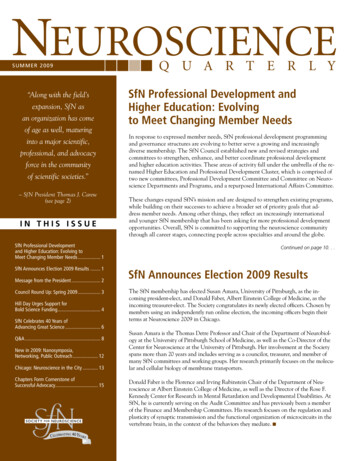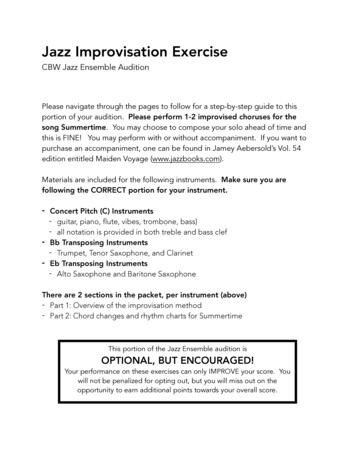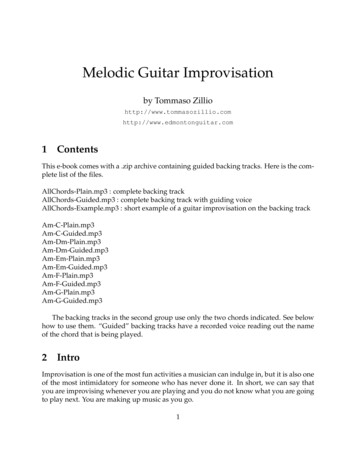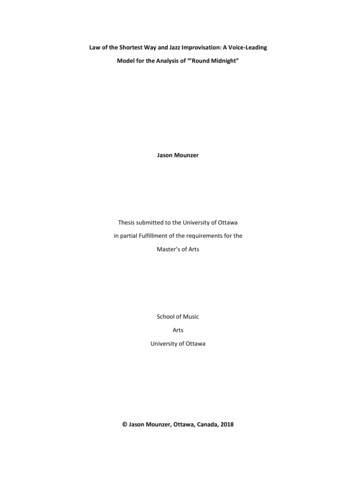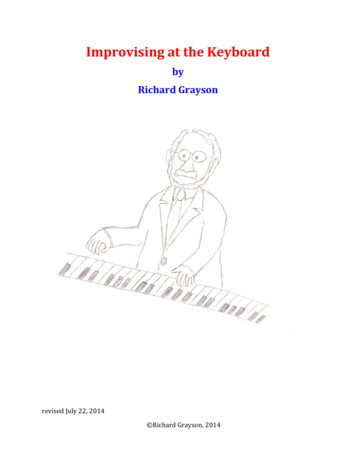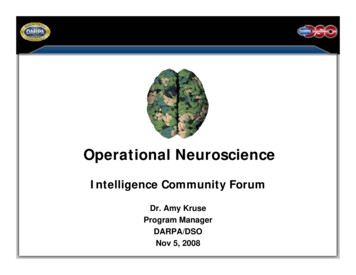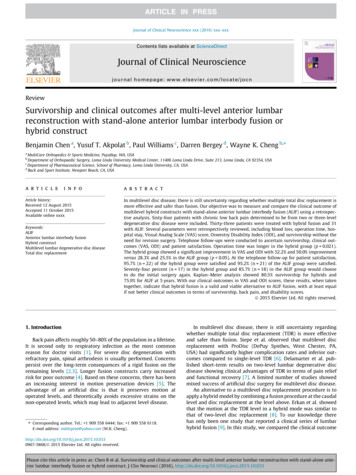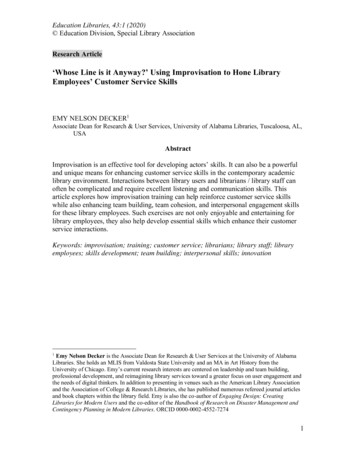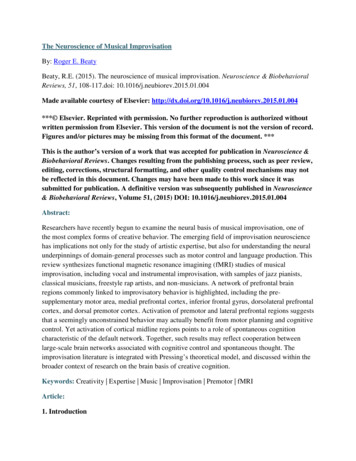
Transcription
The Neuroscience of Musical ImprovisationBy: Roger E. BeatyBeaty, R.E. (2015). The neuroscience of musical improvisation. Neuroscience & BiobehavioralReviews, 51, 108-117.doi: 10.1016/j.neubiorev.2015.01.004Made available courtesy of Elsevier: ** Elsevier. Reprinted with permission. No further reproduction is authorized withoutwritten permission from Elsevier. This version of the document is not the version of record.Figures and/or pictures may be missing from this format of the document. ***This is the author’s version of a work that was accepted for publication in Neuroscience &Biobehavioral Reviews. Changes resulting from the publishing process, such as peer review,editing, corrections, structural formatting, and other quality control mechanisms may notbe reflected in this document. Changes may have been made to this work since it wassubmitted for publication. A definitive version was subsequently published in Neuroscience& Biobehavioral Reviews, Volume 51, (2015) DOI: s have recently begun to examine the neural basis of musical improvisation, one ofthe most complex forms of creative behavior. The emerging field of improvisation neurosciencehas implications not only for the study of artistic expertise, but also for understanding the neuralunderpinnings of domain-general processes such as motor control and language production. Thisreview synthesizes functional magnetic resonance imagining (fMRI) studies of musicalimprovisation, including vocal and instrumental improvisation, with samples of jazz pianists,classical musicians, freestyle rap artists, and non-musicians. A network of prefrontal brainregions commonly linked to improvisatory behavior is highlighted, including the presupplementary motor area, medial prefrontal cortex, inferior frontal gyrus, dorsolateral prefrontalcortex, and dorsal premotor cortex. Activation of premotor and lateral prefrontal regions suggeststhat a seemingly unconstrained behavior may actually benefit from motor planning and cognitivecontrol. Yet activation of cortical midline regions points to a role of spontaneous cognitioncharacteristic of the default network. Together, such results may reflect cooperation betweenlarge-scale brain networks associated with cognitive control and spontaneous thought. Theimprovisation literature is integrated with Pressing’s theoretical model, and discussed within thebroader context of research on the brain basis of creative cognition.Keywords: Creativity Expertise Music Improvisation Premotor fMRIArticle:1. Introduction
Improvisation is one of the most complex forms of creative behavior. The improvising musicianfaces the unique challenge of managing several simultaneous processes in real-time—generatingand evaluating melodic and rhythmic sequences, coordinating performance with other musiciansin an ensemble, and executing elaborate fine-motor movements—all with the overall goal ofcreating esthetically appealing music. Other forms of artistic performance, while similarlydemanding, do not require such spontaneous creativity. The question of how musiciansimprovise is relevant not only to the psychology of music, it also has implications for thepsychology of creativity, as understanding the nature of creativity at a high level of skilledperformance may shed light on domain-general processes underlying creative cognition.Improvisation research may also inform basic cognitive neuroscience because it provides aunique look at how acquired expertise shapes brain structure and function.An increasing number of studies are employing neuroimaging methods to explore the brain basisof spontaneous musical composition, using samples of jazz pianists, classical musicians,freestyle rap artists, and non-musicians. Much of this research has focused on understanding theextent to which brain regions associated with executive control mechanisms underlie improvisedbehavior. Does improvisation rely on the musician’s ability to control the creative process, orrather on his or her ability to “let go” of control and allow spontaneous processes to unfold? Thisreview examines the issue of cognitive control in creative thought with the overarching goal ofunderstanding the cognitive and neural underpinnings of musical improvisation.1.1. Pressing’s model of improvisationPerhaps the most influential model of musical improvisation was developed by Pressing,1988 and Pressing, 1998. Following in the literature on expert performance (Ericsson et al.,1993), Pressing’s theory is grounded in the notion that improvisation is an acquired skill thatrequires a substantial amount of training to achieve expertise. A large body of research in a rangeof domains suggests that expertise is achieved through deliberate practice, an individuallytailored regimen of intensive training typically undertaken with the guidance of an expertinstructor (Ericsson et al., 1993). According to the deliberate practice view, eminence in adomain is rarely achieved without thousands of hours of deliberate practice: Ericsson andcolleagues have repeatedly demonstrated that experts typically engage in 10,000 h of deliberatepractice over the course of ten years before achieving eminence in their field (i.e., the “10-yearrule”; Simon and Chase, 1973). Recently, however, researchers have emphasized the role ofgeneral cognitive abilities (e.g., working memory capacity; Meinz and Hambrick, 2010) andgenetic predispositions (Ericsson, 2013 and Tucker and Collins, 2012) in explaining expertperformance, thus providing support for the notion that practice is “necessary but not sufficient”for high-level performance (Hambrick et al., 2014 and Hambrick and Meinz, 2011).Domain-specific expertise seems especially relevant to musical improvisation. In addition to thephysical and psychological constraints common to other domains of skilled performance, jazzmusicians must perform under extraordinary temporal constraints. Improvising requires the
simultaneous execution of several processes in real-time, including sensory and perceptualencoding, motor control, performance monitoring, and memory retrieval, among others(Pressing, 1988). Deliberate practice automates some of these processes, freeing attentionalresources for other higher-order processes (e.g., generating and evaluating musical ideas). In theabsence of such improvisational fluency, the improviser will have difficulty effectivelyinteracting with other members of an ensemble and exerting control over the development of hisor her performance.According to Pressing’s model, improvisational expertise involves the interplay between referentprocesses and a domain-specific knowledge base. Referents consist of cognitive, perceptual, oremotional processes; the knowledge base consists of hierarchical knowledge structures stored inlong-term memory (Pressing, 1988). Pressing described referents as a series of well-rehearsedretrieval cues that are deployed during performance, minimizing processing demands andguiding idea generation. Referents interact with procedural and declarative information stored ina domain-specific knowledge base. Through deliberate practice, musicians build a database ofgeneralized motor programs, which can be fluently accessed and executed during performance.Another component of Pressing’s model is perceptual feedback and error correction. Theseprocesses allow the improviser to minimize the distance between intended and actualperformance (Pressing, 1988 and Pressing, 1998). Pressing distinguishes between short-term(ongoing motor movements) and long-term (decision making and response selection) feedback—both of which are essential for improvisational fluency. In contrast to “open-loop” theories ofskilled performance, which consist of a simple input, processing, and output procedure, Pressingadvances a “closed loop” model, which extends open-loop models by including feedbackintegration within the system. Ongoing performance is thus monitored by comparing actualoutput with intended output, and future performance is adjusted accordingly.Pressing (1988) conceptualized improvisation as a series of generative and evaluative processes.Although these processes involve some level of cognitive control and conscious monitoring,Pressing emphasized the role of automatized motor processes and routines (e.g., well-rehearsedaction sequences). Because of the high demands on information processing and decision-making,Pressing argued that improvisational fluency relies on automatized processes that requireminimal conscious attention. The extent to which creative thought relies upon such top-down andbottom-up processes remains a point of debate in the literature on musical improvisation as wellas in the literature on domain-general creative cognition (cf. Abraham, 2014, Beaty et al.,2014c, Jung et al., 2013, McMillan et al., 2013,Mok, 2014 and Sowden et al., 2014).1.2. Domain-general creative cognitionThe study of musical improvisation provides an opportunity to investigate creativity at a highlevel of skilled performance. Although improvisation research has traditionally been restricted tothe field of musicology, it is also of growing interest to researchers in the field of creativity
science. Several literature reviews and meta-analyses on the neuroscience of creativity includestudies on musical improvisation (e.g., Dietrich and Kanso, 2010; Gonen-Yaacovi et al., 2013).Moreover, results from behavioral and neurophysiological research suggest that improvisationtaps domain-general processes such as divergent thinking (Beaty et al., 2013) and cognitiveflexibility (de Manzano and Ullén, 2012b).The cognitive and neural basis of creative thought has been a topic of increasing empiricalinterest. Much of this work has employed divergent thinking tasks, the most common of which isthe alternate uses task. Such tasks require the generation of novel uses for everyday objects (e.g.,a brick), and they are typically scored in terms of fluency (the number of ideas) and originality(the creative quality of ideas). A growing body of evidence suggests that individual differencesin divergent thinking reflect a domain-general creative ability: performance on divergentthinking tasks has been shown to predict both past and future creative achievements (Jauk et al.,2014, Plucker, 1999 and Torrance, 1988). Moreover, a recent study found that divergent thinkingability in jazz students predicted expert ratings of improvisational performance, controlling forcumulative lifetime practice hours (Beaty et al., 2013).Researchers have long conceptualized creative cognition as an associative process that passivelyunfolds in long-term memory (Mednick, 1962). In general, such work suggests that creativeideas largely result from the spreading activation of concepts in semantic networks, and thatindividual differences in creative ability result from variation in the structural organization ofsemantic memory. More recently, researchers have explored the cognitive processes involved indivergent thinking, the ability to generate several novel solutions to open-ended problems.Behavioral (Barr et al., 2014, Beaty and Silvia, 2012, Beaty and Silvia, 2013 and Benedek et al.,2014c; Lee and Therriault, 2013; Nusbaum and Silvia, 2011 and Nusbaum et al., 2014; Silvia etal., 2013) and neurophysiological (Beaty et al., 2014a, Beaty et al., 2014b, Benedek et al.,2014, Fink and Benedek, 2014, Fink et al., 2009 and Gonen-Yaacovi et al., 2013) researchsuggests that higher-order cognitive processes underlie creative cognition, such as controlledmemory retrieval, pre-potent response inhibition, fluid intelligence, and working memorycapacity. Such processes are hypothesized to support creative thought by providing the executivecontrol needed to manage complex search processes and inhibit salient conceptual informationthat can interfere with idea generation (Beaty and Silvia, 2012).Recent behavioral and neuroimaging research suggests that musical improvisation may alsorecruit domain-general processes (Beaty et al., 2013 and de Manzano and Ullén, 2012b).Although improvisational expertise, like any other acquired skill, is undoubtedly a function ofdomain-specific training, there is evidence to suggest that divergent thinking and domain-generalmental flexibility play an important role. A growing literature provides support for the notionthat creative cognition recruits brain regions linked with executive processes (e.g., strategicmemory retrieval and pre-potent response inhibition). Nevertheless, the role of executiveprocesses in creative thought remains a point of contention in both the general creativityliterature and the literature on musical improvisation.
1.3. Organization of the reviewThe following review synthesizes neuroimaging research on musical improvisation. Table1 summarizes the studies included in the review; Fig. 1 and Fig. 2 depict activation foci resultingfrom positive task contrasts in select fMRI studies of improvisation. Pressing’s (1988) theoreticalmodel of improvisation is used as a guiding framework for interpreting the brain imagingliterature. The literature is also framed within the ongoing debate on whether creativity arisesfrom controlled cognitive processes. Special attention is given to neuroimaging research ondomain-general creativity, in light of recent evidence pointing to an overlap between generalcreativity and musical improvisation. The review has three broad goals: (1) to synthesize theimprovisation neuroscience literature, (2) to provide a conceptual framework for interpretingbrain imaging results on improvisation, and (3) to integrate these findings with the literature ondomain-general creative thought.Table 1. Summary of methods used to study improvisation with fMRI.StudyYear# ofsubjectsType of musicianContrastResponse typeBengtssonet al.200711Classically-trainedpianists (graduate)Improvise Memoryretri
rather on his or her ability to “let go” of control and allow spontaneous processes to unfold? This review examines the issue of cognitive control in creative

